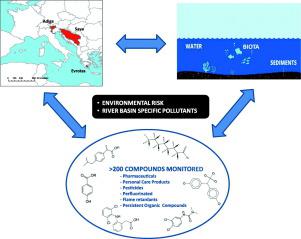Science of the Total Environment ( IF 9.8 ) Pub Date : 2020-09-17 , DOI: 10.1016/j.scitotenv.2020.142344 Marianne Köck-Schulmeyer , Antoni Ginebreda , Mira Petrovic , Monica Giulivo , Òscar Aznar-Alemany , Ethel Eljarrat , Jennifer Valle-Sistac , Daniel Molins-Delgado , M. Silvia Diaz-Cruz , Luis Simón Monllor-Alcaraz , Nuria Guillem-Argiles , Elena Martínez , López de Alda Miren , Marta Llorca , Marinella Farré , Juan Manuel Peña , Ladislav Mandaric , Sandra Pérez , Bruno Majone , Alberto Bellin , Eleni Kalogianni , Nikolaos Th. Skoulikidis , Radmila Milačič , Damià Barceló

|
There is a worldwide growing use of chemicals by our developed, industrialized, and technological society. More than 100,000 chemical substances are thus commonly used both by industry and households. Depending on the amount produced, physical-chemical properties, and mode of use, many of them may reach the environment and, notably, the aquatic receiving systems. This may result in undesirable and harmful side-effects on both the human and the ecosystem's health. Mediterranean rivers are largely different from Northern and Central European rivers in terms of hydrological regime, climate conditions (e.g. air temperature, solar irradiation, precipitation), and socio-economics (e.g. land use, tourism, crop types, etc.), with all these factors leading to differences in the relative importance of the environmental stressors, in the classes and levels of the pollutants found and their environmental fate. Furthermore, water scarcity might be critical in affecting water pollution because of the lowered dilution capacity of chemicals.
This work provides raw chemical data from different families of microcontaminants identified in three selected Mediterranean rivers (the Sava, Evrotas, and Adige) collected during two sampling campaigns conducted in 2014 and 2015 in three different matrices, namely, water, sediments, and biota (fish). More than 200 organic micropollutants were analyzed, including relevant groups like pharmaceuticals, personal care products, perfluorinated compounds, pesticides, pyrethroid insecticides, flame retardants, and persistent organic pollutants. Data obtained were summarized with some basic statistics for all compound families and matrices analyzed. Observed occurrence and spatial patterns were interpreted both in terms of compound physical-chemical properties and local environmental pressures. Finally, their spatial distribution was examined and their ecotoxicological risk in the water phase was assessed. This allowed locating, at each basin, the most polluted sites (“hot spots”) and identifying the respective river basin specific pollutants (RBSPs), prioritizing them in terms of the potential ecotoxicological risk posed to the aquatic ecosystems.
中文翻译:

地中海三个流域的优先和新兴有机微污染物:流域的发生,空间分布和流域特定污染物的识别
我们的发达,工业化和技术社会在全球范围内对化学物质的使用在不断增长。因此,工业和家庭通常使用超过100,000种化学物质。根据产生的数量,物理化学性质和使用方式,其中许多可能会到达环境,尤其是水生接收系统。这可能对人类和生态系统的健康造成不良和有害的副作用。在水文状况,气候条件(例如气温,太阳辐射,降水)和社会经济(例如土地利用,旅游业,作物类型等)方面,地中海河流与北欧和中欧河流有很大不同。这些导致环境压力因素相对重要性差异的因素,所发现的污染物的类别和水平以及它们的环境命运。此外,由于化学品稀释能力的降低,缺水可能对影响水污染至关重要。
这项工作提供了在2014年和2015年进行的两次采样活动中,从三个选定的地中海河流(萨瓦河,埃夫罗塔河和阿迪杰河)中识别出的不同微污染物家族的原始化学数据,这些活动分别在水,沉积物和生物区系(三种)中进行(鱼)。对200多种有机微污染物进行了分析,包括相关组,例如药品,个人护理产品,全氟化合物,农药,拟除虫菊酯杀虫剂,阻燃剂和持久性有机污染物。对于所分析的所有化合物家族和基质,使用一些基本统计数据汇总了获得的数据。根据化合物的物理化学性质和局部环境压力来解释观测到的事件和空间格局。最后,检查了它们的空间分布,并评估了它们在水相中的生态毒理风险。这样就可以在每个流域中找到污染最严重的地点(“热点”),并确定各自的流域特定污染物(RBSP),并根据对水生生态系统构成的潜在生态毒理风险对其进行优先排序。



























 京公网安备 11010802027423号
京公网安备 11010802027423号